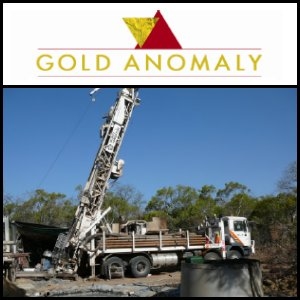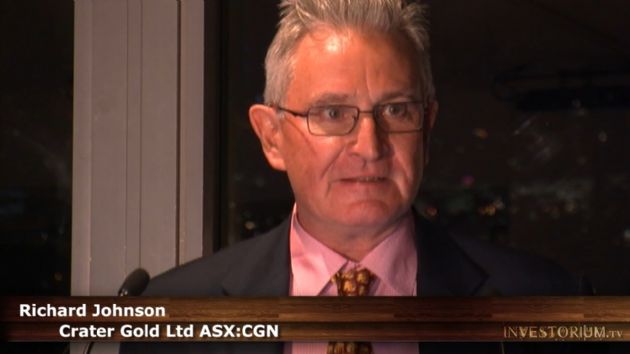
Gold Anomaly Limited (ASX:GOA) Releases Trench Sampling Results Of Sao Chico Gold Project In Brazil
Sydney, Dec 16, 2010 AEST (ABN Newswire) - Gold Anomaly Limited ( ASX:GOA) is pleased to announce that its wholly owned subsidiary Gold Aura Do Brasil Mineracao Ltda (GOAB) is undertaking an ongoing program of trenching at the Sao Chico Gold Project in Brazil.
ASX:GOA) is pleased to announce that its wholly owned subsidiary Gold Aura Do Brasil Mineracao Ltda (GOAB) is undertaking an ongoing program of trenching at the Sao Chico Gold Project in Brazil.
The purpose of this work is to define zones of feed material for the gravity gold plant when installation and commissioning is completed which is currently expected by early in 2011.
TRENCH SAMPLING
To date a total of 21 trenches have been completed for a total north-south trenching length of 644 metres over an east-west strike length of 450 metres and a north-south distance of 300 metres. Individual trenches vary in length from 2 metres to 116 metres. A total of 518 samples have been collected and assayed, with these samples consisting of one and two metre channel samples from the trench walls (the dominant type), rock chip samples from exposed shear hosted veins and samples from rock piles excavated from the trenches. Gold assays were determined by aqua regia digest followed by AAS reading and as such would be expected to be marginally lower in value than if they had been determined by the more traditional fire assay technique.
Of the 518 samples, a total of 22 were reported to contain over 1.0 g/t gold. It should also be noted that many of the trenches have intersected old garimpeiro workings where originally high grade shear zone material has been completely mined out and as a result these zones are not represented in the trench assay results. They do, however, outline high priority targets for drill testing below the trenches where the garimpeiro workings have not reached.
The results show that erratic gold values have been obtained from the 9.0 to 11.0 metre interval in Trench 1, with values of 2.37, 4.32, 15.92 and 112.11 g/t gold being obtained. This highlights the presence of a coarse or "nuggety" gold problem. This problem is encountered in gold projects worldwide, particularly in Proterozoic shear hosted vein gold deposits and arises from a combination of uneven distribution of gold and uneven distribution of gold grain size. In these situations, experience has shown that reliable gold grades can only be obtained if assaying is undertaken on samples in excess of at least 100 kilograms. Accordingly a bulk sample (M-12) of 400 kilograms was collected from the zone in Trench 1 and 80 samples were prepared from 80 individual 5 kilogram sub-samples. From this an average grade of 15.6 g/t gold was obtained for the bulk sample. This is considered to be encouraging as the grade is approaching the targeted feed grade of 20 g/t gold. However, while a grade of 20 g/t gold is being targeted and both test work and mining to determine if this is achievable will be undertaken, it should be noted that this grade is conceptual in nature and that there has been insufficient work undertaken to date to define a Mineral Resource and it is uncertain if further exploration will result in the determination of a Mineral Resource. It should also be noted that the recovery from the 20 g/t target is unknown at this stage but will depend on the grind size of the plant feed. If gold tailings are found to contain significant gold they will be stockpiled for later finer grinding and re-retreatment.
In addition to the bulk sample collected from Trench 1 (M-12), another bulk sample (M-11) was collected from Trench 21. The grade of M-11 based on 80 sub samples has been estimated at 3.7 g/t gold. The M-11and M-12 samples have been despatched for metallurgical test work to fine tune the gravity plant set up. The results from this work are expected within the next one to two weeks and will be used for metallurgical flowsheet refinement and optimisation purposes.
The trenching work within the GUIA licence area has identified additional veins (east-west striking) to the previously known ones and further ones are being identified as the trenching program proceeds. In addition to further veins in the main veined area, new veins have been identified further to the south. While the vein occurrences have yet to be plotted and interpreted, it obvious that there is many more than the five originally mapped (each interpreted to persist intermittently for up to one km along strike). The veins vary in thickness from less than one centimetre to three metres and it is estimated that the aggregate
thickness of all veins currently known over the one km strike length would total around five metres.
About Sao Chico
The Sao Chico project is located along a prominent NW-SE trend which is the most mineralised zone within the Tapajos Mineral Field in central-northern Brazil. The Tapajos field was the site of the biggest gold rush in Brazilian history mainly in the late 1970's and 1980s when approximately 500,000 garimpeiros [artisanal miners] rushed to the area to exploit extensive areas of newly discovered alluvial gold. Approximately 20-30 million ounces of gold were produced [unofficial figures] from these operations before the easily won alluvial gold deposits were largely depleted. The Garimpeiros have little expertise in underground mining and environmental considerations and were thus urged by the government to consolidate their small claims and form joint ventures with established mining companies. The area has had little exploration by modern exploration methods compared to other equivalent gold fields in the world.
The Sao Chico project site is located adjacent to the Trans Garimpeiro Highway and is also serviced by light aircraft from a nearby dirt airstrip. Previous sampling of the sulphide zone vein material by Gold Aura Brasil has returned an average grade of 15 g/t Au, determined from over 100 samples. Gold grades and production from the weathered zone were reported to be erratic in the supergene (weathered and oxidised) zones of the veins and Gold Anomaly is targeting a grade of around 20 g/t from these zones. While a grade of 20 g/t gold is being targeted and trial mining and processing to determine if this is achievable will be undertaken, it should be noted that this grade is conceptual in nature and that there has been insufficient work undertaken to date to define a Mineral Resource and it is uncertain if further exploration will result in the determination of a Mineral Resource.
Gold Aura Brasil's investigations have revealed that the veins are weathered to depths of up to around 10 metres below the surface alluvial cover of approximately five to 10 metres thickness and that the weathered veins are amenable to free digging by excavator. Preliminary test work on finely ground samples has indicated that a high gold recovery can be achieved by gravity concentrating techniques. Gold Aura Brasil plans to mine the weathered vein material by open cut methods under a recently granted GUIA licence to generate a quick cash flow and to provide a better understanding of the mineralisation as part of a feasibility study in preparation for applying for a Mining Lease to mine the underlying unweathered sulphide zone mineralisation.
The GUIA provides for mining and processing of up to 50,000 tonnes of gold mineralised rock per year for up to two years. Over the expected one km strike length of the veins noted to date, it is estimated that the veins have an aggregate thickness of around 5 metres. Therefore it is anticipated that there is sufficient tonnage available to sustain an operation commencing at a rate of 50 tonnes per day and increasing to 100 tonnes per day after two months. At the targeted gold grade of 20 g/t, monthly production of around 2,000 ounces would be expected. Gold recovery will be undertaken via gravity concentration and a processing plant has been purchased from Gekko Systems in Australia. This plant has now arrived in Brazil. The new plant components have been delivered to Site and the used components have cleared customs and are now awaiting transport to site.
As discussed above, new veins are being discovered by the ongoing trenching program and it is expected that more will be progressively exposed.
Tailings dam capacity is available and can be readily expanded as required. There is an ample water supply available from an on-site dam and there is also water available from the numerous shafts developed in the area. Access is excellent as the property lies within a cleared farm area and lies along the main arterial road in the region.
For the complete Gold Anomaly announcement including Trench Sampling Results table, please refer to the following link:
http://www.abnnewswire.net/media/en/docs/64826-ASX-GOA-227487.pdf
Contact
Ken Chapple
Executive Director
Mob: +61-418-758-301
Greg Starr
Executive Chairman
Mob: +61-2-9241-4224
Email: info@goldanomaly.com.au
http://www.goldanomaly.com.au
| ||
|






